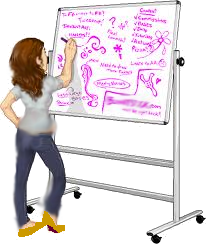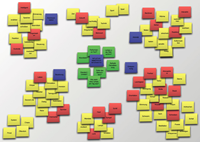Brainstorming in class
 Brainstorming can be used in education to
Brainstorming can be used in education to
 discuss ways of solving a problem and to
discuss ways of solving a problem and to
 find out the depth of pupils understanding and misunderstanding of a topic.
find out the depth of pupils understanding and misunderstanding of a topic.
I always try to start a topic off by brainstorming, so that I know the range of knowledge that exists within the group, and also become aware of any experiments that pupils had experienced during primary education.
It enabled me to tweak my lesson plans for the group so that I did not bore them too much by going over stuff they already knew.
It was also an excellent way of finding out any misconceptions that pupils had. I could therefore focus on removing traces of misunderstanding when that aspect of the topic arose.
 Brainstorming should be relaxed and informal. It is a way in which you can let pupils see that you are approachable, flexible and knowledgable,
Brainstorming should be relaxed and informal. It is a way in which you can let pupils see that you are approachable, flexible and knowledgable,
 Brainstorming should encourage lateral thinking - thoughts and ideas that can, at first, seem a bit crazy or 'wrong' should be included. Some of those ideas can be turned into original, creative solutions to a problem, others can spark even more ideas or lead to discussion as to why they are wrong. It is a way of opening up the minds of a class of pupils and of you getting on their wavelength.
Brainstorming should encourage lateral thinking - thoughts and ideas that can, at first, seem a bit crazy or 'wrong' should be included. Some of those ideas can be turned into original, creative solutions to a problem, others can spark even more ideas or lead to discussion as to why they are wrong. It is a way of opening up the minds of a class of pupils and of you getting on their wavelength.
 During brainstorming sessions, there should be no criticizing or rewarding of ideas. You're trying to open up possibilities and break down incorrect assumptions about the problem's limits. Judgment and analysis at this stage would stunt idea generation and limit creativity. Pupils need to feel they can safely contribute and that you value all contributions.
During brainstorming sessions, there should be no criticizing or rewarding of ideas. You're trying to open up possibilities and break down incorrect assumptions about the problem's limits. Judgment and analysis at this stage would stunt idea generation and limit creativity. Pupils need to feel they can safely contribute and that you value all contributions.
 You should evaluate ideas at the end of the brainstorming session – this is the time to explore alternative solutions further, and introduce the 'correct' solution to the problem.
You should evaluate ideas at the end of the brainstorming session – this is the time to explore alternative solutions further, and introduce the 'correct' solution to the problem.
How to conduct a brainstorming session:
Groups size for brainstorm:
 whole class with teacher out front:
whole class with teacher out front:
- You control the timing and direction of discussion in sessions like these. Know before you start what you want them to find out - and keep an eye on the time so that you draw the ideas together effectively before the lesson ends.
- Ensure everyone can contribute. Often in a lab some students can be seated so that they cannnot see the board or you - think of how they should be seated to best all feel equally valued.
- Try not to just choose the keen 'Hermione Grainger' types
 groups of at least six - preferably twelve - split the class into half or thirds depending on the class size.
groups of at least six - preferably twelve - split the class into half or thirds depending on the class size.
- Make sure that the class are aware of how much time they have to collect ideas, and how long they have to present them to the whole class. Constantly remind them of how much time they have left and what they should have done at each stage. It is a good idea to put a timeline for activity on the whiteboard...
- This grouping will require the group to organise themselves into roles (leader, recorder etc) and that will enable you to see who is confident and organised and who wants to sit back and just listen (or not!). Use the session to get to know the personality types of the group - their strengths and weaknesses.
- you have to leave enough time at the end of the session for the groups to feedback to the whole class and then for you to sum up findings. You should have the last word - stating the finding that you wanted to convey to the group.
Recording the ideas

 use the whiteboard to write down their ideas - pupils like to write their ideas on the board themselves - encourage it! (this works well for a 'whole class' session.
use the whiteboard to write down their ideas - pupils like to write their ideas on the board themselves - encourage it! (this works well for a 'whole class' session.
 use post it notes - they write their ideas on the notes and then stick them on the board. This is excellent for group feedback to the whole class - each group can have different colour notes. The advantage of this method is that you can take the post-its away at the end of the lesson!
use post it notes - they write their ideas on the notes and then stick them on the board. This is excellent for group feedback to the whole class - each group can have different colour notes. The advantage of this method is that you can take the post-its away at the end of the lesson!
 hand out A3 sheets to groups of about 8-10 pupils - they brainstorm in groups and then share their evaluation of the brainstorm with the class. Again the sheets can be collected in by you and serve as evidence of work done by each group. The A3 sheets can then be photographed (using an ipad or phone) and shared with the whole class via the school network.
hand out A3 sheets to groups of about 8-10 pupils - they brainstorm in groups and then share their evaluation of the brainstorm with the class. Again the sheets can be collected in by you and serve as evidence of work done by each group. The A3 sheets can then be photographed (using an ipad or phone) and shared with the whole class via the school network.



 Brainstorming can be used in education to
Brainstorming can be used in education to 



